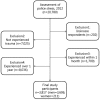Post-traumatic stress disorder and occupational characteristics of police officers in Republic of Korea: a cross-sectional study
- PMID: 26951212
- PMCID: PMC4785329
- DOI: 10.1136/bmjopen-2015-009937
Post-traumatic stress disorder and occupational characteristics of police officers in Republic of Korea: a cross-sectional study
Abstract
Objective: South Korean police officers have a greater workload compared to their counterparts in advanced countries. However, few studies have evaluated the occupational challenges that South Korean police officers face. Therefore, this study aimed to evaluate the police officer's job characteristics and risk of post-traumatic stress disorder (PTSD) among South Korean police officers.
Design: Cross-sectional study.
Setting: Police officers in South Korea.
Participants: 3817 police officers with a traumatic event over a 1-year period.
Main outcome measures: Officers with a response to the Impact of Event Scale (revised Korean version) score of ≥ 26 were classified as high risk, and we evaluated their age, sex, department and rank, as well as the frequency and type of traumatic events that they experienced.
Results: Among the respondents, 41.11% were classified as having a high risk of PTSD. From the perspective of the rank, Inspector group (46.0%) and Assistant Inspector group (42.7%) show the highest frequencies of PTSD. From the perspective of their working division, Intelligence and National Security Division (43.6%) show the highest frequency, followed by the Police Precinct (43.5%) and the Traffic Affairs Management Department (43.3%). It is shown that working in different departments was associated with the prevalence of PTSD (p=0.004).
Conclusions: The high-risk classification was observed in 41.11% of all officers who had experienced traumatic events, and this frequency is greater than that for other specialised occupations (eg, firefighters). Therefore, we conclude that groups with an elevated proportion of high-risk respondents should be a priority for PTSD treatment, which may help increase its therapeutic effect and improve the awareness of PTSD among South Korean police officers.
Keywords: MENTAL HEALTH; PUBLIC HEALTH.
Published by the BMJ Publishing Group Limited. For permission to use (where not already granted under a licence) please go to http://www.bmj.com/company/products-services/rights-and-licensing/
Figures
Similar articles
-
Do police officers and firefighters have a higher risk of disease than other public officers? A 13-year nationwide cohort study in South Korea.BMJ Open. 2018 Jan 31;8(1):e019987. doi: 10.1136/bmjopen-2017-019987. BMJ Open. 2018. PMID: 29391373 Free PMC article.
-
Post-traumatic stress symptoms in an elite unit of Brazilian police officers: prevalence and impact on psychosocial functioning and on physical and mental health.J Affect Disord. 2007 Jan;97(1-3):241-5. doi: 10.1016/j.jad.2006.06.004. Epub 2006 Jul 20. J Affect Disord. 2007. PMID: 16859752
-
Posttraumatic Stress Disorder Is a Risk Factor for Multiple Addictions in Police Officers Hospitalized for Alcohol.Eur Addict Res. 2019;25(4):198-206. doi: 10.1159/000499936. Epub 2019 May 22. Eur Addict Res. 2019. PMID: 31117072
-
Systematic review of posttraumatic stress disorder in police officers following routine work-related critical incident exposure.Am J Ind Med. 2020 Jul;63(7):600-615. doi: 10.1002/ajim.23120. Epub 2020 May 17. Am J Ind Med. 2020. PMID: 32419181
-
Post-traumatic Stress Disorder.Int J Occup Environ Med. 2012 Jan;3(1):2-9. Int J Occup Environ Med. 2012. PMID: 23022845 Review.
Cited by
-
Posttraumatic stress disorder and depression after the 2018 Strasbourg Christmas Market terrorist attack: a comparison of exposed and non-exposed police personnel.Eur J Psychotraumatol. 2023;14(2):2214872. doi: 10.1080/20008066.2023.2214872. Eur J Psychotraumatol. 2023. PMID: 37305952 Free PMC article.
-
Prevalence and factors associated with potential substance use disorders among police officers in urban Tanzania: a cross-sectional study.BMC Psychiatry. 2023 Mar 16;23(1):175. doi: 10.1186/s12888-023-04663-6. BMC Psychiatry. 2023. PMID: 36927411 Free PMC article.
-
Mental Disorders and Mental Health Promotion in Police Officers.Health Psychol Res. 2024 Feb 17;12:93904. doi: 10.52965/001c.93904. eCollection 2024. Health Psychol Res. 2024. PMID: 38375073 Free PMC article.
-
Factors influencing post-traumatic stress disorder among police officers in South Korea.Front Public Health. 2022 Dec 9;10:1024284. doi: 10.3389/fpubh.2022.1024284. eCollection 2022. Front Public Health. 2022. PMID: 36568755 Free PMC article.
-
Increased risk of developing cerebro-cardiovascular diseases in police officers: a nationwide retrospective cohort study.Clin Hypertens. 2024 Jul 1;30(1):18. doi: 10.1186/s40885-024-00277-6. Clin Hypertens. 2024. PMID: 38946000 Free PMC article.
References
-
- Yehuda R. Post-traumatic stress disorder. N Engl J Med 2002;346:108–114.. - PubMed
-
- First MB. Diagnostic and statistical manual of mental disorders. DSM IV-4th edn APA, 1994:97–327.
MeSH terms
LinkOut - more resources
Full Text Sources
Other Literature Sources
Medical

